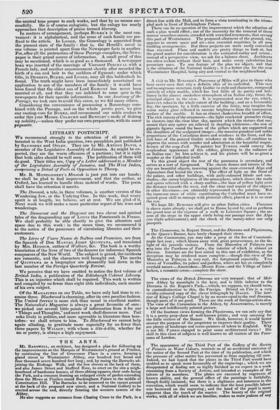A visit to Mr. Bviwonn's Panorama of Milan will give
to those who have never seen that city a definite idea of its cathedral. This vast and incongruous structure, truly Gothic in style and character, composed entirely of white marble, which has lost little of its purity and bril- liancy in the almost smokeless atmosphere of an Italian city, forms the principal object in the view. It is represented near the eye, which, however, takes in the whole extent of the building ; and on a favourable day, the spectator, by a little exercise of the fancy, may imagine the warm sunny glow reflected in roseate brightness from the transparent surface of the marble. It has an almost shadowless breadth of effect. The rich tracery of the ornaments—the light crocketed pinnacles rising in clusters into the clear blue sky, against which the statues that sur- mount their airy spires are relieved in dazzling whiteness—the row of gigantic figures round the bases of the pillars which are supported on the shoulders of the sculptured images—the massive grandeur and noble proportions of the Corinthian doors and windows in the front, and the rich hues of the painted Gothic windows at the side—all combine to impress the senses with wonder and admiration at the beautiful magni- ficence of the coup No painter but TURNER could convey the resplendent appearance of this edifice, glittering in the radiance of an Italian sun : let him achieve it, and his picture will be as great a wonder as the Cathedral itself.
To this grand object the rest of the panorama is secondary, and serves as a sort of foreground. The classic domes and turrets of the city are beautiful objects, towering against the snow-crowned Alps and Apennines that bound the view. The effect of light on the front of the palace, and other buildings, with gaily-coloured blinds and sun- shades—the sunny brightness of the atmosphere, which shows the roofs and spires relieved with a sharp outline—the haze of yellow light over the distance towards the west, and the clear cool aspect of the objects in other directions—are admirably represented in the painting. But the immense mass of white constituting the Cathedral must have re- quired great skill to manage with pictorial effect, placed as it is so near the eye. We hope Mr. BURFORD :will give us other Italian cities. Florence is above stairs already ; we shall get to Rome by and by, and so perform the grand tour at the expense of a walk to Leicester Square ; the as- cent of the steps to the upper circle being our passage over the Alps (no slight achievement), and the cheek of the money-taker our only passport.


























 Previous page
Previous page